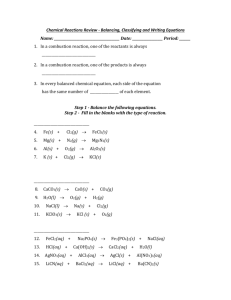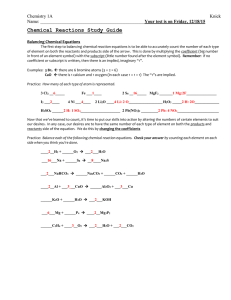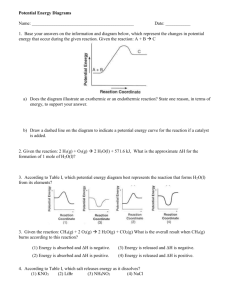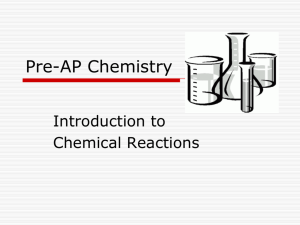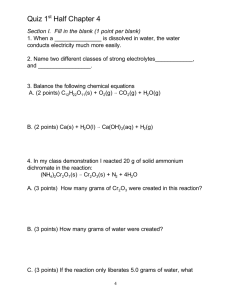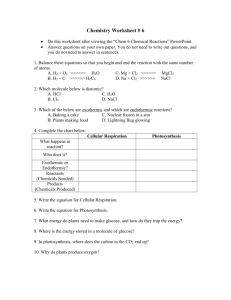Review Worksheet for Exam 2 Chem 101, Summer 2006
advertisement
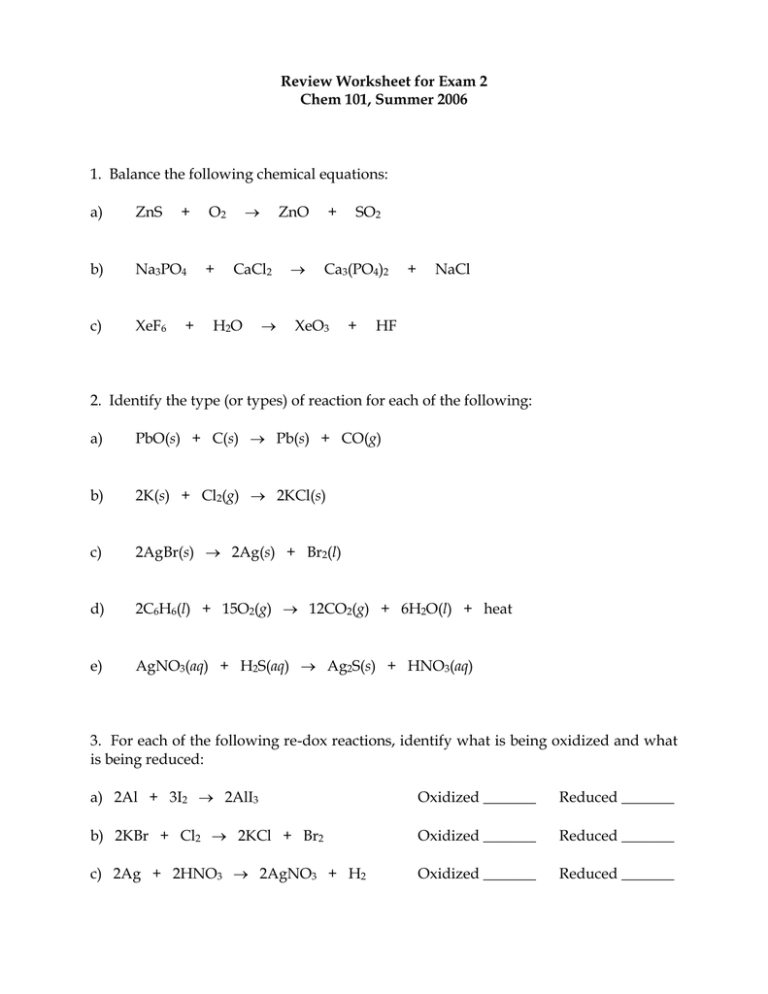
Review Worksheet for Exam 2 Chem 101, Summer 2006 1. Balance the following chemical equations: a) ZnS + b) Na3PO4 c) XeF6 + ZnO CaCl2 O2 + H2O + SO2 Ca3(PO4)2 XeO3 + + NaCl HF 2. Identify the type (or types) of reaction for each of the following: a) PbO(s) + C(s) Pb(s) + CO(g) b) 2K(s) + Cl2(g) 2KCl(s) c) 2AgBr(s) 2Ag(s) + Br2(l) d) 2C6H6(l) + 15O2(g) 12CO2(g) + 6H2O(l) + heat e) AgNO3(aq) + H2S(aq) Ag2S(s) + HNO3(aq) 3. For each of the following re-dox reactions, identify what is being oxidized and what is being reduced: a) 2Al + 3I2 2AlI3 Oxidized _______ Reduced _______ b) 2KBr + Cl2 2KCl + Br2 Oxidized _______ Reduced _______ c) 2Ag + 2HNO3 2AgNO3 + H2 Oxidized _______ Reduced _______ 4. Complete and balance the following chemical equations (include physical states): a) K(s) + b) H2CO3(aq) c) CuCl2(aq) d) C3H8(g) e) Ca(s) Br2(l) + + + Na2S(aq) O2(g) HCl(aq) 5. Draw an energy diagram for a chemical reaction that has the following characteristics: exothermic and fast reaction. Label the axes, reactants, transition state, products, activation energy and heat of reaction on your diagram. 6. How would each of the following change the rate of the following reaction? 2Mg + O2 2MgO + Heat a) The reaction is cooled to 0C Faster Slower b) The reaction is done in an atmosphere of pure O2 instead of in air (air is a mixture of gases that include O2) Faster Slower 7. Which way will the equilibrium of the following reversible reaction be shifted under each of the following conditions: N2 + O2 + heat 2NO a) Heat is added to the reaction Towards Reactants Towards Products b) NO is added to the reaction Towards Reactants Towards Products c) O2 is added to the reaction Towards Reactants Towards Products 8. Consider the compound Mg(OH)2 a) How many atoms of oxygen are in 2.0 moles of Mg(OH)2? b) How many moles of Mg(OH)2 contain 1.5 x 1023 atoms of Mg? c) How many grams of hydrogen are in 5.0 g of Mg(OH)2? 9. Consider the following reaction: 2Al + Fe2O3 Al2O3 + 2Fe + 204 kcal a) What type of reaction is this (besides redox)? Combination Decomposition Replacement Combustion b) Identify what in the reaction is oxidized and what is reduced: Oxidized ________ Reduced ________ c) Is the reaction exothermic or endothermic ? d) How many grams of Fe2O3 are required to react with 5.00 g of Al? e) If 1.0 mol Al is reacted with 1.0 mol Fe2O3, which is the limiting reactant? (Circle your answer) Al or Fe2O3 10. Calculate the % composition by mass for Na2S 11. Consider the following reaction: 2H2 + O2 2H2O a) If 10.0 g of H2 is reacted with 10.0 g of O2, which is the limiting reactant? b) What is the theoretical yield? c) If 10.0 g of H2O is produced, what is the % yield? 12. Consider the following reaction: PCl5 PCl3 + Cl2 a) Write the equilibrium expression: b) If Keq = 2 x 10-2, does the equilibrium favor reactants (or) products (or) neither ? c) If Cl2 is removed from the reaction, does the Keq get larger (or) smaller (or) neither ? 13. Complete the following statements regarding gases: a) At constant T and n, the volume ______________ when P is decreased. b) At STP, the volume ______________ when n is increased. c) At constant V and n, the temperature ______________ when P is increased. d) At constant P and n, the density ______________ when T is decreased. 14. A steel cylinder with a volume of 25.0 L is filled with 125 g of O2 gas at 20.0C (R = 0.0821 L atm/mol K). a) What is the pressure (in atm) of O2 gas in the cylinder? b) If 500.0 g of N2 gas is added to the cylinder, what is the total pressure in the cylinder? 15. What is the density (in g/L) of H2S gas at STP? 16. A balloon is filled with He gas to a volume of 1.0 L. If the pressure and the moles of He are held constant, and the temperature goes from 20.0C to 40.0C, what is the new volume? 17. Consider the following reaction: 2H2(g) + O2(g) 2H2O(g) a) How many liters of H2 gas are required to react with 1.0 L of O2 gas at STP? b) How many liters of H2O gas are produced when 10.0 g of H2 gas are reacted with sufficient O2 at STP? 18. Indicate whether each of the following substances are soluble in water: a) CaOH b) K2S c) H2S d) Ba(NO3)2 e) PbSO4 f) C8H18 19. Write a balanced equation for the dissociation of the following electrolytes in water: a) NaNO3 (strong) b) Cu(NO3)2 (strong) c) HF (weak) 20. KCl has a solubility of 42.6 g/100 g H2O at 50C. How many grams of KCl are required to make a saturated solution with 50.0 mL of H2O at 50.0C? (density of H2O = 1.00 g/mL) 21. KCl has a solubility of 42.6 g/100 g H2O at 50C and 34.0 g/100 g H2O at 20C. If a saturated solution of KCl is made with 50.0 mL of H2O at 50C and then cooled to 20C, how many grams of KCl will precipitate out of the solution? (density of H 2O = 1.00 g/mL) 22. If ale is 7.5% (v/v) alcohol, how many ounces of alcohol will you consume if you drink 4.0 pints? (1 pint = 16 oz) 23. If you were in the laboratory, how would you prepare each of the following solutions? a) 1.0 L of 5.0% (m/v) glucose b) 5.00 L of 0.100 M HCl 24. Consider the following reaction: Na2CO3(aq) + 2HCl(aq) CO2(g) + H2O(l) + 2NaCl(aq) How many mL of a 2.00 M HCl solution are required to react with 3.00 g of Na2CO3? 25. State whether each of the following substances would form a solution, colloid or suspension when mixed with water: a) starch b) NaCl c) oil d) glucose 26. Equal volumes of two solutions, A and B, are placed into a beaker where they are separated by a semi-permeable membrane that allows only water to pass through. A = 1.0 M NaCl and B = 1.0 M CaCl2. a) Which solution has the higher osmotic pressure? b) On which side (A or B) will the volume increase over time? 27. What happens to a red blood cell when it is placed into each of the following: a) sea water b) distilled water 28. If a mixture of protein, starch, glucose and NaCl in water is placed into a dialysis bag, and the bag is put into a beaker of distilled water, which components will flow out of the bag?

